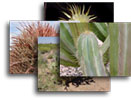Notes for the Genus: espostoopsis |
Etymology - Espostoa and the greek opsis meaning like. Hence "Espostoa-like"
As the name implies,Espostoopsis is very similar to the genus Espostoa. Aside from being disjunct geographically with the single species in Espostoopsis being native to Brazil as opposed to western South America, the differences are not readily apparent. Interestingly, further investigation revealed that taxonomists have never placed this species in Espostoa despite their strong similarities. This is not because it was always a stand alone species either as it was listed in both Austrocephalocereus and Coleocephalocereus before getting a name of its own in 1968.
Unlike Espostoa, Espostoopsis flower tubes are naked, hence the comparison with Coleocephalocereus and Micranthocereus. Fruits and seeds are less conclusive, partly because they are so variable within Espostoa. Some species have smooth shiny seeds and some rougher, even tuberculate, seed. Espostoopsis has dark tuberculate seed. Some obvious differences arise in the fruit stem as a result of the flower differences.
DNA study clearly separated Espostoopsis from three species of Espostoa. It recognized a well-defined group of species with cephalia and naked flowers, including Espostoopsis, Arrojadoa, Coleocephalocereus, Micranthocereus, and also Cipocereus, Melocactus, and Discocactus. Notice that Cipocereus doesn't even have a cephalium, but it is suggested that it may have had one and lost it. Or maybe it arose from hybridization with a non-cephalium species.
Espostoa was found within a less cohesive group of hairy-flowered Trichocereeae including Cleistocactus (which has been successfully crossed with Espostoa), Denmoza, Haageocereus, Oreocereus, Samaipaticereus, Matucana, Oroya, and Echinopsis. The study suggested that the old genus Vatricania, for Espostoa guentheri, may be a valid distinction from other Espostoas and is closer to Cleistocactus, Denmoza, and some Echinopsis. The species with shiny seeds, E. melanostele and E. nana, were not included in the study so the validity of Backeberg's genus Pseudoespostoa isn't clear.
In any case, the singular species in the genus is a low-branching columnar with many ribs. It has a wooly appearance due to the wooly white hairs that obscure the stems and give rise to central spines which extend well past the hairy covering. White, bell-shaped flowers form out of a lateral cephalium.
Espostoopsis is known in cultivation, but seldom reaches maturity in pots and is grown more as a novelty for its hairy appearance.
-Ian Nartowicz is co-author of this description. |
*Currently 1 of 1 known species are represented on CactiGuide.com.

Do you have images of this species that would complement this page?
Visit the Big Picture Project to to learn how you can contribute.
|
|